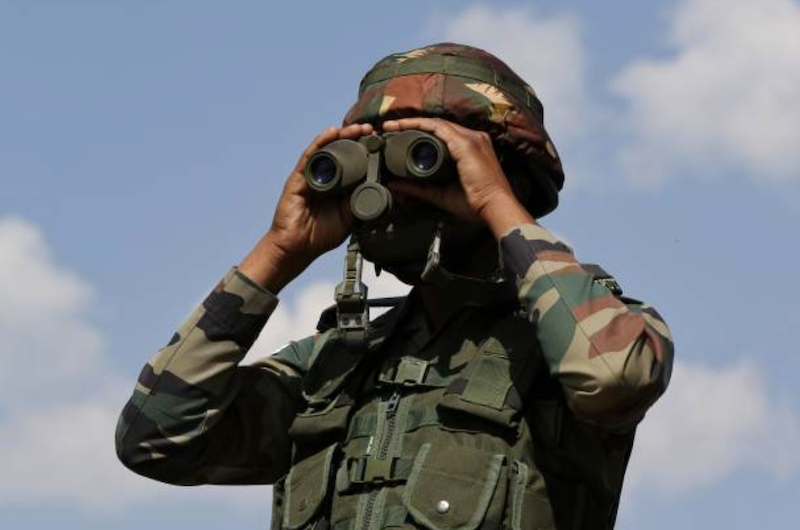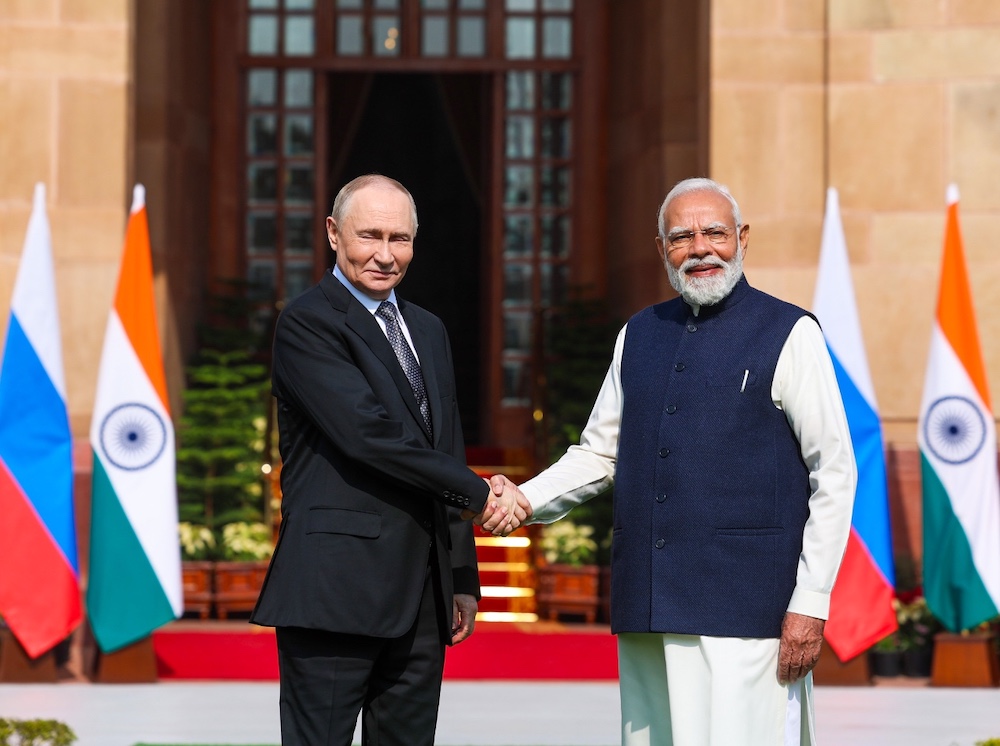 An Indian soldier keeps watch at the LoC in Kashmir.
An Indian soldier keeps watch at the LoC in Kashmir.
Capturing Pakistan-occupied Kashmir is an ambition repeatedly expressed by our politicians, sometimes directly and sometimes through the military top brass. After the-then chief of Army staff, General Bipin Rawat, had publicly made a statement to this effect back in 2019, it has been reiterated by the Chinar (XV) Corps commander, followed by the Northern Army commander. These pronouncements have come in wake of the desire for an Akhand Bharat expressed by the defence minister, Rajnath Singh. No wonder that the brand-new Pakistani army chief has responded with the threat of “taking the fight back to the enemy”, in case of such adventurism on India’s part.
The resolution adopted by Parliament in February 1994 during the government headed by the-then prime minister, PV Narsimha Rao, states “the state of Jammu & Kashmir has been and shall be an integral part of India” The resolution also demanded: “Pakistan must vacate the areas of the Indian state of Jammu & Kashmir, which they have occupied through aggression.”
The intent, thus, having been made clear, now presents several questions which both the military and political leadership need to consider to achieve the goal of recapturing and integrating POK with India. First of all, the issue to be considered is whether it is realistically possible to recapture POK in the present-day strategic scenario? If so, how can this aim be achieved and what is the likely cost the nation will have to bear to achieve the intent of the parliamentary resolution? Another question that needs to be addressed is whether regaining physical control of POK is the only solution to the vexed problem of Kashmir or some other solutions have to be thought of?
It is important to delve a little into the history and geography of the area. Almost 30 per cent area of undivided J&K is under the illegal occupation of Pakistan, which they had annexed violently in 1947. This was a result of the hesitation on part of the maharaja of Kashmir to accede to India, which had become inevitable after Pakistan dishonoured the “Standstill Agreement” and sent in tribal raiders to capture Kashmir. By the time the “instrument of accession” was signed in October 1947, enabling induction of the Indian Army to defend Kashmir, the “kabailis” (raiding tribesmen) had already occupied a large portion of the Kashmir valley. Later, the Indian Army wrested back a large portion of the captured land. However, some areas remained under control of Pakistan by time the ceasefire agreement was signed at Karachi, in 1949. The ceasefire line roughly conforms to the alignment of “line of control (LoC)”, which was agreed upon after the Simla Agreement, in 1972. Both countries also had agreed to resolve the dispute bilaterally as per the 1972 agreement.
There are further complications in the POK issue. Apart from the area under the illegal occupation of Pakistan, about 10 per cent of Kashmir is under illegal Chinese occupation. Pakistan has also gifted about 5,000 square kilometres of “Trans-Karakoram Tract” or “Shaksgam Tract” of POK to China under a China-Pakistan treaty signed in 1963. This area is now part of Xinjian-Uighur Autonomous Region.
POK can further be divided into two parts – Pakistan-controlled Kashmir and Gilgit-Baltistan region.
Video: Can India take POK back? Here’s what senior veterans who commanded troops in J&K say
The United Nations security council had passed a resolution (UNSC Resolution 47) in April 1948 for holding a plebiscite in Kashmir after India took the Kashmir issue to it. Under the resolution, a plebiscite in Kashmir was to be conducted after following two conditions were met:
a. Complete withdrawal of troops by Pakistan from Kashmir.
b. India to retain minimal presence of troops.
However, since Pakistan never withdrew its troops, a plebiscite could not be conducted. Now, a plebiscite is ruled out altogether because Pakistan will never withdraw its troops from POK. From India’s perspective, a plebiscite does not guarantee that the population of POK will necessarily opt for India. It is noteworthy that despite a long-running insurgency in Jammu & Kashmir, in which Kashmiris have suffered immensely and generated much bitterness towards India among them, they have always acted to help the Indian Army whenever the Pakistanis have dared to attack India, be it in 1947, 1965, 1971 or during the Kargil war in 1999.
Repeated pronouncements of capturing POK emanate from lack of strategic thinking and appreciation of ground realities. A matured military leadership will never underestimate the adversary’s capabilities and will to fight. They must advise the government correctly – like the-then Army chief, General SHFJ Manekshaw, did in 1971.
The numerical superiority of Indian defence forces notwithstanding, claims of outright victory are far-fetched because of likely threats from our northern neighbour, China, which is a close ally of Pakistan. Besides, India is beset with the problem of obsolete equipment, shortage of ammunition, large deficiency of aircraft, etc. The Indian military also is deficient in manpower because of regular recruitment having been deferred for the last few years in view of the Agniveer recruitment scheme.
Read also: How good it is to have contract soldiers in tour of duty?
Furthermore, the strategists will have to consider two additional factors while planning an audacious move like “recapturing” POK. The first one is the China-Pakistan Economic Corridor (CPEC) – the 3,000km Chinese infrastructure network project passing through POK. The Chinese will not let this sea-and-land-based corridor aimed to secure and reduce the passage for China’s energy imports be threatened. They will certainly come forward to support Pakistan in the event of an Indian threat to POK. The other factor is the portion of Kashmir under illegal occupation of China. Have the strategists analysed the implications of use of force to capture this strategically located area?
Strategists will blunder if they fail to appreciate that operations will not remain restricted to the LoC only. Like India did in 1965, Pakistan, especially because it is guaranteed Chinese support, will open the front along the international border starting from Jammu to Gujarat. The Indian military leadership cannot afford to ignore the imponderable factor of the thinking process of the Pakistani military and political leadership.
This entails that large resources will remain committed to defend the IB, thus making them unavailable for offensive along the LoC. The much higher ratio of troops required for offensive in mountainous terrain as compared to plains will, therefore, not be available.
Lessons of Kargil cannot be lost upon our political and military leaders. It took India over a month to evict the enemy in a small subsector of the LoC at a heavy cost in terms of deaths and injuries to soldiers, despite the Indian military having total freedom of air operations. The war effort in the case of recapturing POK will be spread over the entire stretch of the LoC. Outcome of such war effort in high reaches with extremely limited lines of communications, lack of clear superiority in the number of troops and an environment where air dominance is not guaranteed will be extremely difficult to predict.
Read also: Kargil Vijay Diwas – to celebrate or introspect?
Considering that our forces can break through enemy defences along the LoC and advance to the interiors, we cannot be certain of the wholehearted support of the population of POK. Much as we would like to believe that the residents of POK are not happy with the Pakistani regime, the actual situation on ground may not be in line with our expectations. After all, as discussed above, haven’t the Kashmiris, despite their cries of “azadi” (freedom) supported the Indian Army during all the wars with Pakistan? Assumption that Indian forces will be welcomed with open arms in POK is erroneous and fraught with the possibility of our troops getting embroiled in an insurgency even in that part of Kashmir.
The only factor which appears favourable is the state of economy of Pakistan, which may collapse within a few days of operation. However, even our economy too is not doing well presently and a war as short as one week will lead to the further deterioration of our economic health, from which it will take a very long time to recover.
Another factor to be considered is the reaction of world powers to any such eventuality. While our diplomacy appears to have succeeded in convincing the world about our point of view regarding recent developments in Kashmir, that may change if a war takes place. While we have excellent relations with the United States, Pakistan continues to remain an important ally for them as a frontline state in their world view. Even Russia has developed good relations with Pakistan. Open military and logistic support to Pakistan by China is inevitable as discussed above. The global panic we witnessed during limited cross-border military actions like the “surgical strikes” of 2016 and air skirmish of February 2019 indicate that other world powers will immediately initiate action to contain the conflict given that both India and Pakistan possess nuclear weapons.
War is a serious matter that cannot be left to the whims and fancies of individuals whether military or political. These are always discussed away from public glare except when decision makers wish to divert the attention of masses from other important domestic issues. Presently, that appears to be the case.
Follow us here:
Twitter: https://twitter.com/indiasentinels
Facebook: https://facebook.com/indiasentinels
Instagram: https://instagram.com/indiasentinels
YouTube: https://youtube.com/indiasentinels
Disclaimer: The views expressed in the article are the author’s own and don’t necessarily reflect the views of India Sentinels.
© India Sentinels 2022-23










